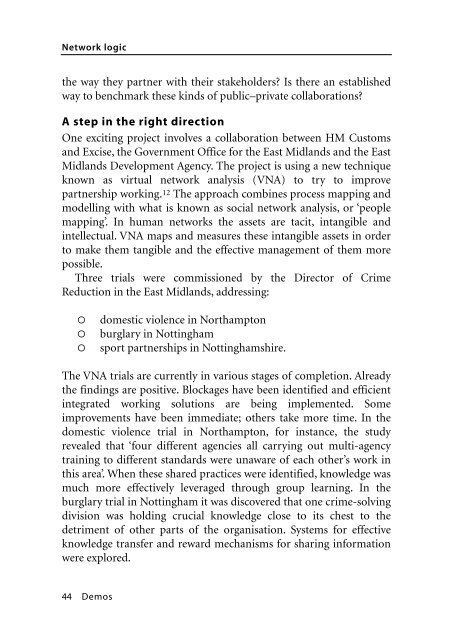Network Logic - Index of
Network Logic - Index of
Network Logic - Index of
Create successful ePaper yourself
Turn your PDF publications into a flip-book with our unique Google optimized e-Paper software.
<strong>Network</strong> logic<br />
the way they partner with their stakeholders? Is there an established<br />
way to benchmark these kinds <strong>of</strong> public–private collaborations?<br />
A step in the right direction<br />
One exciting project involves a collaboration between HM Customs<br />
and Excise, the Government Office for the East Midlands and the East<br />
Midlands Development Agency. The project is using a new technique<br />
known as virtual network analysis (VNA) to try to improve<br />
partnership working. 12 The approach combines process mapping and<br />
modelling with what is known as social network analysis, or ‘people<br />
mapping’. In human networks the assets are tacit, intangible and<br />
intellectual. VNA maps and measures these intangible assets in order<br />
to make them tangible and the effective management <strong>of</strong> them more<br />
possible.<br />
Three trials were commissioned by the Director <strong>of</strong> Crime<br />
Reduction in the East Midlands, addressing:<br />
domestic violence in Northampton<br />
burglary in Nottingham<br />
sport partnerships in Nottinghamshire.<br />
The VNA trials are currently in various stages <strong>of</strong> completion. Already<br />
the findings are positive. Blockages have been identified and efficient<br />
integrated working solutions are being implemented. Some<br />
improvements have been immediate; others take more time. In the<br />
domestic violence trial in Northampton, for instance, the study<br />
revealed that ‘four different agencies all carrying out multi-agency<br />
training to different standards were unaware <strong>of</strong> each other’s work in<br />
this area’. When these shared practices were identified, knowledge was<br />
much more effectively leveraged through group learning. In the<br />
burglary trial in Nottingham it was discovered that one crime-solving<br />
division was holding crucial knowledge close to its chest to the<br />
detriment <strong>of</strong> other parts <strong>of</strong> the organisation. Systems for effective<br />
knowledge transfer and reward mechanisms for sharing information<br />
were explored.<br />
44 Demos
















